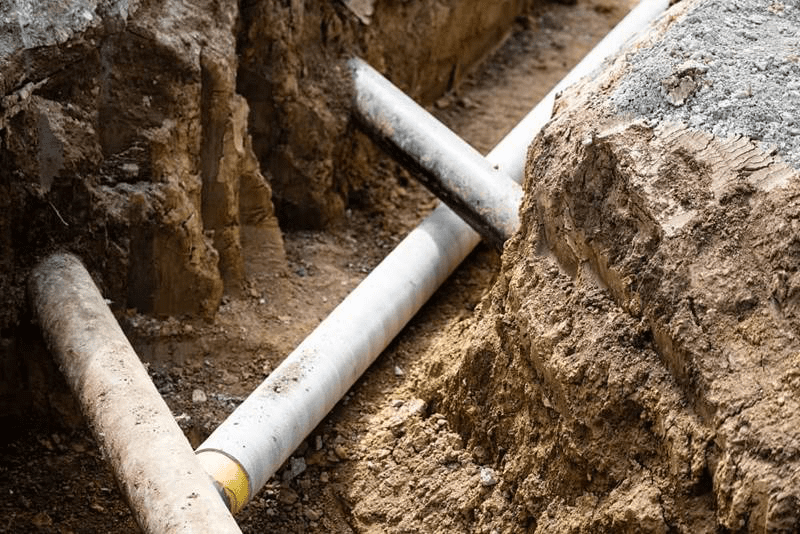In 1976, workers hit a cross-bored gas line while using a sewer drain cleaner. When the drain cleaner hit the line, an explosion occurred. Two people lost their lives, four individuals sustained injuries, and the explosion destroyed one home. This led to more people becoming aware of cross-bores and the surrounding safety concerns.
What is a Directional Cross-Bore?
Many companies today benefit from trenchless technology. They no longer need to dig a trench to install utility lines. With the help of this technology, they drill horizontally and install new lines. This leads to less disruption and less restoration work.
However, with trenchless technology comes directional cross-bores. When utility lines intersect, a cross-bore occurs. The intersection of these utilities leads to problems with either of the pipelines by disrupting the flow within or the integrity of the pipelines.
Detecting a Cross-Bore
A person might not know a cross-bore affects their sewer line. The problem continues undetected until a sewage backup occurs or another problem develops within the sewer line. In fact, people often suspect they have a sewer lateral that is blocked or obstructed by tree roots.
At times, they believe shifting soils have led to problems within this line. They call a plumber for help in cleaning the line or making the repair. Using a drill with a cross-bore can lead to disaster.
The Dangers Associated with Cross-Bores
When a homeowner requests a plumbing inspection, they need to have this inspection conducted with a camera. This ensures the plumber doesn’t use a drill to clear debris when a cross-bore is present.
If they don’t do a pipe inspection prior to drilling, they may hit an active gas line. This could lead to an explosion and the death of one or more individuals. In addition, nearby buildings could sustain significant damage.
Why is This Concern Increasing?
Many homeowners are now calling for sewer line repair or replacement. They realize the piping infrastructure in this country is aging, which means problems may be imminent. By calling for sewer line repair before problems arise, they hope to protect their property from damage.
When the technician arrives, they must conduct a plumbing inspection with a camera to look for cross-bores. Thanks to the increased usage of trenchless technology, this issue has become more commonplace.
One way to detect these cross-bores is with the help of a thorough pipe inspection. The other option is to dig up the entire sewer line, but property owners want to avoid this. The cost of restoring the property is lower when the contractor uses trenchless technology, which is why more people request this option today.
However, if the use of trenchless technology leads to a cross-bore, the cost of the repair could increase. Who prevents cross-bores?
Preventing Cross-Bores
Plumbers, building contractors, and more use plumbing cameras today to find sewer lines and potential cross-bores. This is much easier than trying to track the sewer lines manually and ensures all potential cross-bores are located before any work is done. In addition, this method works better than the locating beacon method when cast-iron pipes are involved.
Municipalities and utility owners need to work together to prevent cross-bores. When they do so, they help to keep costs down. Property owners appreciate this because they know this will help to keep their costs down as well.
However, when a cross-bore occurs on an individual’s property, the property owner is responsible for the repairs. The property owner will need to determine who must pay for the repairs after speaking with a plumber and determining whether a cross-bore is the issue.
Why Conduct a Camera Inspection?
Any time a plumbing repair is needed, request a camera inspection to find all areas of pipe damage. This inspection allows the technician to see all pipe damage before starting any plumbing repair. While the contractor may use a locating beacon, it isn’t as accurate with all piping materials.
In addition, the inspection allows the property owner to see the damage themselves. Often, they find this visual helpful in determining the best course of action for the repair. They know what the problem is and can discuss the various repair options with the plumber.
Property owners should always ensure all sewer laterals and other utilities on their property are marked prior to having any work done. In the past, utilities would often mark a property with the location of sewer and water lines and other utility lines buried underground.
This same step needs to be completed when using trenchless technology to reduce the risk of problems. The contractor must identify and mark all lines.
Learn more about this type of inspection before having any work done on the property, as a camera inspection will help to find cross-bores and provide the owner with peace of mind. They will know the property won’t sustain damage while they are trying to improve it.

